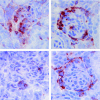The role of neutrophils in the induction of glomerulonephritis by anti-myeloperoxidase antibodies
- PMID: 15972950
- PMCID: PMC1603451
- DOI: 10.1016/S0002-9440(10)62951-3
The role of neutrophils in the induction of glomerulonephritis by anti-myeloperoxidase antibodies
Abstract
In humans, circulating anti-neutrophil cytoplasm autoantibodies (ANCAs) with specificity for myeloperoxidase (MPO) are strongly associated with the development of pauci-immune necrotizing and crescentic glomerulonephritis (NCGN). In mice, we have demonstrated that intravenous injection of mouse antibodies specific for mouse MPO induces NCGN that closely mimics the human disease. We now report that the development of NCGN in this experimental model is accompanied by glomerular accumulation of neutrophils and macrophages. Neutrophil infiltration was most conspicuous at sites of glomerular necrosis and crescent formation, with macrophages also most numerous in crescents. Lymphocytes, however, were sparse in acute lesions. Importantly, mice that were depleted of circulating neutrophils with NIMP-R14 rat monoclonal antibodies were completely protected from anti-MPO IgG-induced NCGN. These findings provide direct evidence that neutrophils play a major role in the pathogenesis of anti-MPO-induced NCGN in this animal model and implicate neutrophils in the induction of human ANCA disease. This raises the possibility that therapeutic strategies to reduce circulating neutrophils could be beneficial to patients with ANCA-induced NCGN.
Figures




Similar articles
-
Impact of anti-glomerular basement membrane antibodies and glomerular neutrophil activation on glomerulonephritis in experimental myeloperoxidase-antineutrophil cytoplasmic antibody vasculitis.Nephrol Dial Transplant. 2016 Apr;31(4):574-85. doi: 10.1093/ndt/gfv384. Epub 2015 Nov 17. Nephrol Dial Transplant. 2016. PMID: 26582929
-
Bone marrow-derived cells are sufficient and necessary targets to mediate glomerulonephritis and vasculitis induced by anti-myeloperoxidase antibodies.J Am Soc Nephrol. 2006 Dec;17(12):3355-64. doi: 10.1681/ASN.2006070718. Epub 2006 Nov 15. J Am Soc Nephrol. 2006. PMID: 17108314
-
Anti-neutrophil cytoplasmic antibodies and effector CD4+ cells play nonredundant roles in anti-myeloperoxidase crescentic glomerulonephritis.J Am Soc Nephrol. 2006 Jul;17(7):1940-9. doi: 10.1681/ASN.2006020108. Epub 2006 Jun 12. J Am Soc Nephrol. 2006. PMID: 16769746
-
The role of myeloperoxidase and myeloperoxidase-antineutrophil cytoplasmic antibodies (MPO-ANCAs) in the pathogenesis of human MPO-ANCA-associated glomerulonephritis.Clin Exp Nephrol. 2013 Oct;17(5):634-637. doi: 10.1007/s10157-013-0787-7. Epub 2013 Mar 16. Clin Exp Nephrol. 2013. PMID: 23504409 Free PMC article. Review.
-
Contribution of myeloperoxidase in vasculitis development.Jpn J Infect Dis. 2004 Oct;57(5):S2-3. Jpn J Infect Dis. 2004. PMID: 15507759 Review.
Cited by
-
Pathogenesis of antineutrophil cytoplasmic autoantibody-associated small-vessel vasculitis.Annu Rev Pathol. 2013 Jan 24;8:139-60. doi: 10.1146/annurev-pathol-011811-132453. Annu Rev Pathol. 2013. PMID: 23347350 Free PMC article. Review.
-
IgG glycan hydrolysis attenuates ANCA-mediated glomerulonephritis.J Am Soc Nephrol. 2010 Jul;21(7):1103-14. doi: 10.1681/ASN.2009090984. Epub 2010 May 6. J Am Soc Nephrol. 2010. PMID: 20448018 Free PMC article.
-
ANCA-associated vasculitides-lessons from the adult literature.Pediatr Nephrol. 2010 Aug;25(8):1397-407. doi: 10.1007/s00467-010-1496-z. Epub 2010 Apr 1. Pediatr Nephrol. 2010. PMID: 20358231 Review.
-
Phosphatidylinositol 3-Kinase δ Deficiency Protects From Antimyeloperoxidase Vasculitis.Arthritis Rheumatol. 2023 Jan;75(1):64-70. doi: 10.1002/art.42298. Epub 2022 Nov 18. Arthritis Rheumatol. 2023. PMID: 35818684 Free PMC article.
-
Pathogenesis of antineutrophil cytoplasmic autoantibody vasculitis.Curr Opin Nephrol Hypertens. 2011 May;20(3):263-70. doi: 10.1097/MNH.0b013e3283456731. Curr Opin Nephrol Hypertens. 2011. PMID: 21422922 Free PMC article. Review.
References
-
- Falk RJ, Jennette JC. Anti-neutrophil cytoplasmic autoantibodies with specificity for myeloperoxidase in patients with systemic vasculitis and idiopathic necrotizing and crescentic glomerulonephritis. N Engl J Med. 1988;318:1651–1657. - PubMed
-
- Goldschmeding R, van der Schoot CE, ten Bokkel Huinink D, Hack CE, van den Ende ME, Kallenberg CG, von dem Borne AE. Wegener’s granulomatosis autoantibodies identify a novel diisopropylfluorophosphate-binding protein in the lysosomes of normal human neutrophils. J Clin Invest. 1989;84:1577–1587. - PMC - PubMed
-
- Jennette JC, Hoidal JR, Falk RJ. Specificity of anti-neutrophil cytoplasmic autoantibodies for proteinase 3. Blood. 1990;75:2263–2264. - PubMed
-
- Jennette JC, Falk RJ. Small-vessel vasculitis. N Engl J Med. 1997;337:1512–1523. - PubMed
-
- Savige J, Davies D, Falk RJ, Jennette JC, Wiik A. Antineutrophil cytoplasmic antibodies (ANCA) and associated diseases. Kidney Int. 2000;57:846–862. - PubMed
Publication types
MeSH terms
Substances
Grants and funding
LinkOut - more resources
Full Text Sources
Other Literature Sources
Research Materials
Miscellaneous

